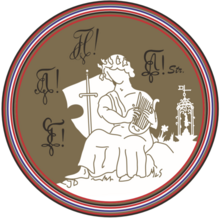Red fraternities cartel
| Red fraternities cartel (KRB) | |
|---|---|
| Establishment date | February 10, 2008 |
| Colleges | Eberhard Karls University of Tübingen , Justus Liebig University of Gießen , Julius Maximilians University of Würzburg , Georg-August University of Göttingen |

|
|
The Kartell Roter Burschenschaften, also known as KRB for short, is a loose association between four fraternities of the former Red Direction , which have set themselves the goal of exchanging fraternity work.
The "red principle"
In contrast to the “white principle”, the so-called red principle stands for less decadence and luxury, a simple way of life and for scientific pursuit. The war of 1870/71 threatened to flatten the fraternity movement; there was also a lack of community spirit and a sense of responsibility. So in 1883 the reform fraternity, Neogermania Berlin , was founded, which was seen as an impetus for further new reform fraternities. The umbrella organization of these fraternities became the General German Burschenbund . The aims of these fraternities were simplistic: the maintenance of the fraternity's history, the cultivation of a patriotism independent of party and church politics, with equal rights for all those with a sense of German without racial difference, against anti-Semitism. In addition, there were regulations for physical training and the "equal rights of Bursch and Fux". The ADB dissolved, but the most important principles of the reform fraternities were retained by the members of the Red Direction.
Features / principles
The cartel of the Red Fraternities, while maintaining the independence of each individual fraternity, is intended to maintain friendly relationships and a close exchange of ideas, including promoting personal contact between the members.
aims
The aim of the red fraternities cartel is to emphasize and enliven, consolidate and implement old fraternity principles.
Aspirations
- Dissemination of fraternity ideas in all academic circles.
- Lively participation in the processes of political life and their treatment in scientific-political circles, constant commitment to the freedom and unity of Germany with Western European objectives with emphasis on the German community of fate with all like-minded circles, but rejecting joint activity and determination in party-political terms.
- Rejection of a one-sided weapons student and all exaggerations in appearance and effort, compliance with simple ways of life.
- Strict upbringing and self-education of the federal brothers on the basis of fraternity-student tradition, general attitude and self-control, morally an impeccable lifestyle, physical courage and efficiency while advocating the designated censorship as a means of education.
- Combating all influences threatening the German people.
history
Emerging from the friendship relationships of the old North German cartel from 1855–1872, the Red Direction was created on January 10, 1920 , renewed as an old-school working group on June 14, 1951, dissolved on July 5, 1982 and re-established on June 2, 2001. The two remaining fraternities of the Red Direction (fraternity Holzminda Göttingen and Strasbourg fraternity Arminia zu Tübingen) merged on February 10, 2008 with the Würzburg fraternity Arminia, a former fraternity of the Red Direction to form the Kartell Roter Fraternities.
Daniel Krieger (member of the Strasbourg fraternity Arminia zu Tübingen), who, after years of mere meetings with the fraternity Arminia Würzburg in the context of the so-called four-person meeting, made the former friendship meeting of the fraternities Schlägel and Eisen Clausthal, Marchia Bonn Arminia Würzburg and Arminia Strasbourg decided to motivate the Würzburg fraternity Arminia to found an association of the remaining leagues and former leagues of the Red Direction. After several organized meetings in Tübingen and mutual visits to the respective university cities, the company took shape. The commitment of Gernot Stengel (member of the Gießener Burschenschaft Germania and the Strasbourg Burschenschaft Arminia zu Tübingen) also had a supportive effect, who, from the point of view of the old rulers, ideally opened the gates for the foundation and encouraged Aktivitas in it. In particular, he encouraged his first association, Germania Gießen, to get in touch on this matter.
Members
Today the following fraternities belong to the “Kartell Roter Burschenschaften (KRB)”
- Würzburg Burschenschaft Arminia (founded December 12, 1848)
- Giessen fraternity Germania (founded August 14, 1851)
- Fraternity Holzminda Göttingen (founded November 10, 1860)
- Strasbourg fraternity Arminia zu Tübingen (founded January 18, 1886)
See also
Sources and literature
- Hans-Georg Balder: The German fraternities. Their representation in individual chronicles. Hilden 2005, p. 35.
- Herman Haupt (Hrsg.): Handbook for the German fraternity. Brönner, Frankfurt 1925, p. 70.
- Max Droßbach and Hans Hauske (eds.): Handbook for the German fraternity. 6th edition, Berlin 1932, p. 435ff.
- Sonja Kuhn: The German Burschenschaft - a grouping in the field of tension between traditional formalism and traditional foundation - an analysis for the period 1950 to 1999. Stuttgart 2002, ISBN 3-00-009710-4 , p. 105.
- Peter Frömke: Holzminda in the red direction. In: Hansheiner Schumacher (Ed.): Burschenschaft Holzminda Göttingen. Contributions to its history 1860–1985. Göttingen 1985, pp. 124-132.
- Helma Brunck: The German Burschenschaft in the Weimar Republic and in National Socialism. Universitas, Munich 1999, ISBN 3-8004-1380-9 , also: Dissertation, University of Mainz, 1996.


